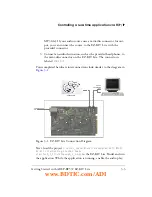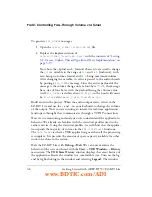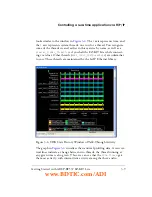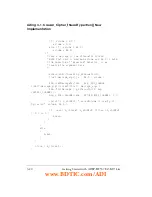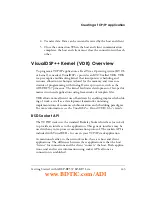
Getting Started with ADSP-BF537 EZ-KIT Lite
3-13
Controlling a real-time application via TCP/IP
3. The LwIP stack services the keystroke by passing it to our
Caesar
Cipher
thread (thread ID 8). Control moves between thread IDs 8
and 2 to get the keystroke to the worker thread.
4. The
Caesar Cipher
thread posts a message (
VOL_CHANGE
) to the
Attenuator
(thread ID 6), where it is serviced.
5. In the meantime, another block of audio has become ready to pro-
cessor. Rather than returning to the (lower priority) Caesar Cipher
thread, control moves to the
Input
thread, and the block of audio
is processed much like it was in step 2.
6. When the audio block is finished, control returns to the lower pri-
ority
Caesar Cipher
thread. Our breakpoint was set just after this
point.
Part 3: Tuning Application
Although we have plenty of available spare capacity in the application as
is, it is worth revisiting optimization techniques introduced in the earlier
chapters. The three “easy” ways to performance-tune this application are:
• Turn on the compiler’s optimizations
• Enable the ADSP-BF537 processor’s instruction cache
• Increase the speed at which the processor runs
Click the
Target Load
page of the
VDK State History
window. Observe
the percentage load over time. In its current non-optimized state, average
load is around 25%, sometimes peaking to 100% for brief periods of time
when processing Ethernet packets.
First, turn on the compiler’s optimizations. Switch from the Debug con-
figuration to the Release configuration, then build, load, and run the
application. After a few seconds of audio, halt and revisit the
Target Load
www.BDTIC.com/ADI
Содержание EZ-KIT Lite ADSP-BF537
Страница 4: ...www BDTIC com ADI ...
Страница 8: ...CONTENTS viii Getting Started with ADSP BF537 EZ KIT Lite www BDTIC com ADI ...
Страница 52: ...Listing 1 3 Exercise 1 Part 3 1 30 Getting Started with ADSP BF537 EZ KIT Lite www BDTIC com ADI ...
Страница 88: ...What s Next 3 22 Getting Started with ADSP BF537 EZ KIT Lite www BDTIC com ADI ...





